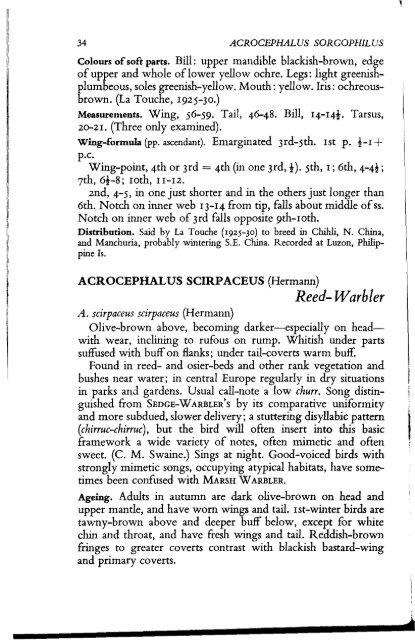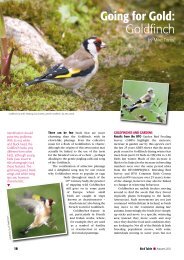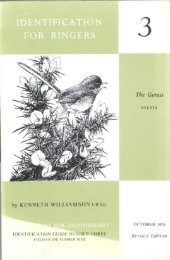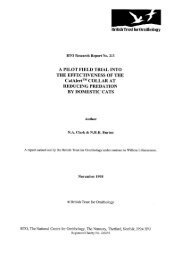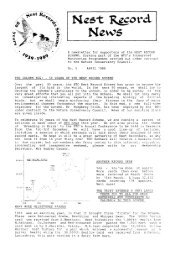Warbler - British Trust for Ornithology
Warbler - British Trust for Ornithology
Warbler - British Trust for Ornithology
You also want an ePaper? Increase the reach of your titles
YUMPU automatically turns print PDFs into web optimized ePapers that Google loves.
34 ACROCEPHALUS SORGOPHILUS<br />
Colours ofsoft parts. Bill: upper mandible blackish-brown, edge<br />
ofupper and whole oflower yellow ochre. Legs: light greenishplumbeous,<br />
soles greenish-yellow. Mouth: yellow. Iris: ochreousbrown.<br />
(La Touche, 1925-30.)<br />
Measurements. Wing, 56-59. Tail, 46-48. Bill, 14-14t. Tarsus,<br />
20-21. (Three only examined).<br />
Wing-<strong>for</strong>mula (pp. ascendant). Emarginated 3rd-5th. 1st p. t-I+<br />
p.c.<br />
Wing-point, 4th or 3rd = 4th (in one 3rd, t). 5th, I; 6th, 4-d;<br />
7th, 6t-8; loth, II-I2.<br />
2nd, 4-5, in one just shorter and in the others just longer than<br />
6th. Notch on inner web 13-14 from tip, falls about middle ofss.<br />
Notch on inner web of 3rd falls opposite 9th-loth.<br />
Distribution. Said by La Touche (1925-30) to breed in ChiWi, N. China,<br />
and Manchuria, probably wintering S.E. China. Recorded at Luzon, Philippine<br />
Is.<br />
ACROCEPHALUS SCIRPACEUS (Hermann)<br />
Reed- <strong>Warbler</strong><br />
A. scirpaceus scirpaceus (Hermann)<br />
Olive-brown above, becoming darker-especially on headwith<br />
wear, inclining to rufous on rump. Whitish under parts<br />
suffused with buffon flanks; under tail-eoverts warm buff<br />
Found in reed- and osier-beds and other rank vegetation and<br />
bushes near water; in central Europe regularly in dry situations<br />
in parks and gardens. Usual call-note a low churr. Song distinguished<br />
from SEDGE-WARBLER'S by its comparative uni<strong>for</strong>mity<br />
and more subdued, slower delivery; a stuttering disyllabic pattern<br />
(ch irruc-chirruc) , but the bird will often insert into this basic<br />
framework a wide variety of notes, often mimetic and often<br />
sweet. (c. M. Swaine.) Sings at night. Good-voiced birds with<br />
strongly mimetic songs, occupying atypical habitats, have sometimes<br />
been confused with MARSH WARBLER.<br />
Ageing. Adults in autumn are dark olive-brown on head and<br />
upper mantle, and have worn wings and tail. 1st-winter birds are<br />
tawny-brown above and deeper buff below, except <strong>for</strong> white<br />
chin and throat, and have fresh wings and tail. Reddish-brown<br />
fringes to greater coverts contrast with blackish bastard-wing<br />
and primary coverts.


